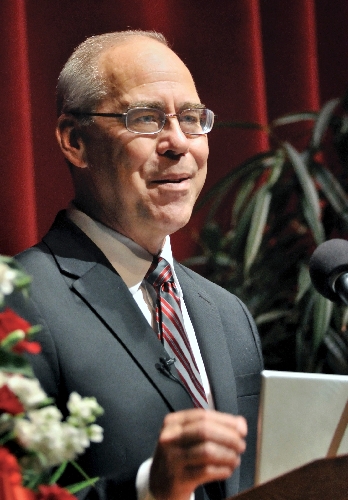UNLV officials now planning a 50,000-seat stadium

Plans to build an outdoor football arena seating 40,000 on UNLV’s campus are dead, the university’s president said Thursday. Instead, officials plan to develop a 50,000-seat stadium on the site.
That was one of the changes to the project UNLV President Neal Smatresk announced Thursday. Another was in how the project might be financed. A special taxing district, once seen as essential, might not be necessary, he said.
The higher education system’s Board of Regents agreed Thursday to extend for another 180 days an exclusive negotiating agreement between UNLV and Majestic Realty to develop the project. Regent Mark Alden was the only vote against the extension. He opposed making the agreement exclusive, given that the University of Nevada, Las Vegas sits on public land.
A consultant said the larger stadium gives more flexibility and doesn’t limit the types of events that could be attracted to Las Vegas.
Eventually, plans are to include the stadium, shopping, student housing and parking on the site, now the parking lot for the Thomas & Mack Center on the corner of Tropicana and Swenson avenues.
No public money has been spent on the project, said Gerry Bomotti, the university’s senior vice president for finance and business.
He said none would be spent, either.
Backers and university officials announced the project in February. They had planned on getting legislative approval to create a special tax district wherein taxes collected on the site would help fund the project.
But the Legislature failed to pass such a measure.
Smatresk said that failure gave officials time to rethink what had been a rapidly planned project.
He brought in an expert, University of Michigan sports management professor Mark Rosentraub, to help revamp the plans.
Rosentraub has consulted on stadiums around North America, including the Staples Center in Los Angeles, Lucas Oil Stadium, where the Indianapolis Colts play, and a new arena for the Edmonton Oilers hockey team.
“It’s not about a sports facility,” Rosentraub said. “It’s about what a sports facility does for the environment it’s in.”
UNLV is unique because it’s in Las Vegas, an entertainment designation without a 50,000-seat, state-of-the-art arena or stadium, he said. That gives the university and its partner, Majestic Realty, the opportunity to seek private investors.
Craig Cavileer, president of the Silverton and a Majestic executive, told the regents that the project probably would be completed in stages.
The stadium would come first.
“Our enthusiasm for this project is as strong as ever,” he said. “This is a big vision, and those don’t happen overnight.”
Both he and Smatresk said it is too early to know whether the tax district will be necessary eventually.
Smatresk said another financing option might be naming rights, but that was only a possibility.
He said the student village concept — student housing, shops and parking — will not go away.
“That is essential,” he said.
Rosentraub, who called the student village concept “critical,” said the project as a whole must be based on what the market will bear and will have to be able to sustain itself financially.
“I think it can be done,” he told the board. “If I didn’t think it could be done, I wouldn’t be here.”
Rosentraub and university officials told the regents that they would use the next several months to come up with detailed plans for the stadium and surrounding facilities. They expected to have it completed in the first quarter of 2012, with some details to follow.
They will present those plans to the board in June.
Contact reporter Richard Lake at rlake@reviewjournal.com or 702-383-0307.